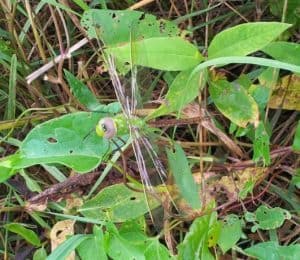
Fall is the time for many animals to migrate south. We know that many species of birds migrate and also that Monarch Butterflies migrate. But did you know that Green Darner Dragonflies also migrate? Green Darners are large, strong dragonflies. Males are about 3 ” long, with a 2″-wide wingspan. Both male and female have bright green thoraxes. Males have a blue abdomen, while females have a brown abdomen. Both have golden wings. Green Darners also have a different hunting style. Most other dragonflies t perch on the tip of a plant and fly out briefly to catch an insect. But Green Darners are almost always on the wing, catching insects. They rarely need to alight. When they do alight and rest, they favor the tops of trees. As a result, its extremely difficult to get a photo of these dragonflies.
Green Darners are strong and fast fliers. They migrate individually, not in swarms, thus do not attract attention of predators. In October, I was on an Amtrak train, looking out the window. I saw a Green Darner keeping up with the speeding train and staying level with my window. My thought was that it was using the train for drafting and increased speed, much as dolphins do with ships.
The complete life cycle of these insects was only fully determined in 2018. The results of a migration study by Hallworth et.al, were published in Biology Letters, December 2018 and titled “Tracking dragons: stable isotopes reveal the annual cycle of a long-distance migratory insect.” The team of researchers discovered a new technique of determining where an individual green darner was hatched. They found that when the insects are in their larval stage in ponds, their bodies take on nuclear isotopes from the water. By clipping a small portion of wing on a captive dragonfly, the researchers could determine the approximate location of its birth. They describe their results as follows: “We determined the full annual cycle of a large migratory dragonfly, the common green darner (Anax junius). We demonstrate that darners undertake complex long-distance annual migrations governed largely by temperature that involve at least three generations. In spring, the first generation makes a long-distance northbound movement (further than 650 km) from southern to northern range limits, lays eggs and dies. A second generation emerges and returns south (further than 680 km), where they lay eggs and die. Finally, a third resident generation emerges, reproducing locally and giving rise to the cohort that migrates north the following spring.
If you’re traveling south this fall or winter, you may spot one of these beauties. And you can be on the lookout for them here in Westford in the spring.
———————–
Many thanks to all flora and fauna reporters for the month of October. Please send reports for the next column by November 26. You can write me at 7A Old Colony Drive, call me at 692-3907, or e-mail me at mariancharman@gmail.com
Late September Report:
Gerry DiBello, Court Rd. September 29, ” We have a water dish for birds in one of our garden bags. I lift it up to change the water in the dish. For at least two weeks I’ve seen a yellow spotted salamander living under the center of the dish. I’ve left it alone.” [Absolutely the right thing to do Gerry-MH]
October Reports:
Marian/Bill Harman, Old Colony Drive. October 2, 70 degrees. Four white-throated sparrows here for the first time this fall. Seven goldfinches, 2 titmice, 3 chickadees. October 3, 50’s, beautiful foliage in the wetlands. At feeder, blue jay, grackle, 2 titmice, 5-6 juvenile goldfinches begging from their parents. A great blue heron flew from the forest to the pond low over my head. It had a chipmunk in its beak. It flew onto a patch of mud and kept dunking it in the water and shaking it. Finally it gulped it down whole. At Frances Hill Wildlife Sanctuary, hairy woodpecker seen. October 4, 50’s, rainy, 4 titmice, 3 chickadees, a house finch, 2 mourning doves, a red-bellied woodpecker, two white-breasted nuthatches, 7 goldfinches, a rabbit, 2 chipmunks. At West Prescott St., two white-throated sparrows, one song sparrow, two tree sparrows, one blue jay. October 6, 60’s, sunny. At feeder: flock of about 20 grackles at feeder. October 7, 60’s, sunny, one cardinal, grackles, chickadee. October 12–seen on Facebook: video of a Sora, vocalizing in wetlands on Wing Rd. First junco reported in Westford.
Erika Kohl, Francis Hill Rd. Oct. 13, “Rob just saw a small adult black bear crossing Chamberlain towards the Frances Hill Conservation area.”
Diane Duane, Howard Ed, October 15, Monarch Butterfly on our butterfly bush [Very pretty photo-MH].
Marian Harman is a member of the Westford Conservation Trust, a non-profit conservation organization. The Trust welcomes new members and volunteers. Check out our website at westfordconservationtrust.org or visit us on Facebook.
